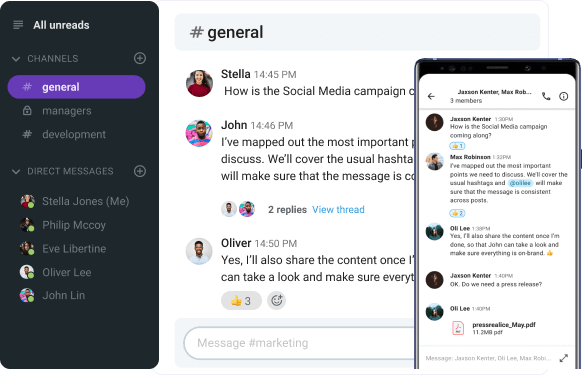If you’re thinking trends in business communication are just industry buzz, think again.
They’re profoundly shaping your organization’s success, right now.
Consider this — nearly half of all employees report that ineffective communication directly saps their productivity. That’s a significant chunk of lost potential!
However, trends in corporate communication, which refer to currently popular communication methods, are prone to constant changes, so it is important to keep up with the current business communication trends.
So, where is business communication headed in 2025 and beyond?
Let’s dive into the top trends that are already redefining the business landscape.

Table of Contents
Trend #1: Hybrid work is the established norm
The hybrid work model, a flexible blend of in-office and remote work, has solidified its position as the standard practice.
Employees increasingly value the flexibility to choose where and when they work, leading to:
- Better work-life balance,
- Increased autonomy, and often,
- Higher productivity.
Moreover, one survey on best employee benefits shows that 20% of employees would quit their jobs if they couldn’t work remotely.
Therefore, companies are investing in solutions to make hybrid and remote environments truly equitable and seamless for all employees, regardless of their physical location.
Trend #2: Business communication channels are unified
Have you ever experienced being in a workplace where people communicate via several communication channels, such as messages in a workplace chat app, emails, phone calls, text messages, and so on?
It’s a mess.
Many messages get left out and communication becomes a juggling act that drains employees of precious time and energy.
In 2025, the trend is towards unified communication experiences. Businesses are seeking integrated platforms that combine instant messaging, voice calls, video conferencing, file sharing, and even third-party app integrations into a single, intuitive ecosystem.
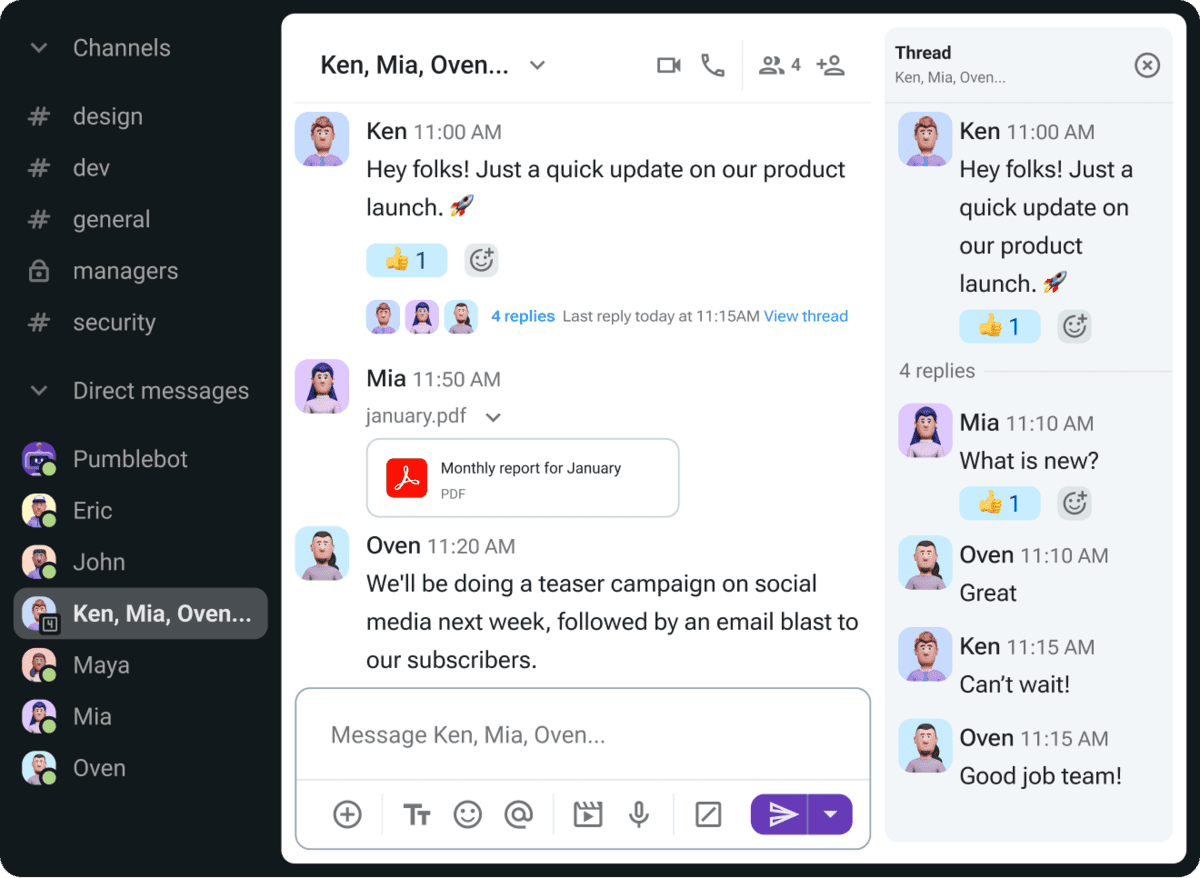
This “less is more” approach streamlines workflows, reduces app fatigue, and fosters more cohesive collaboration.
Furthermore, features such as thread communication have proven to be an effective weapon for keeping your conversations neat and more streamlined.
This brings us to our next communication trend.
Trend #3: Work communication apps are becoming mainstream
Business messaging apps are not just popular — they are indispensable.
These platforms facilitate real-time idea exchange, instruction delivery, and feedback.
Beyond basic messaging, advanced features like thread communication and status updates are helping create clearer communication boundaries, allowing employees to detach from work when needed, promoting a healthier work-life balance.
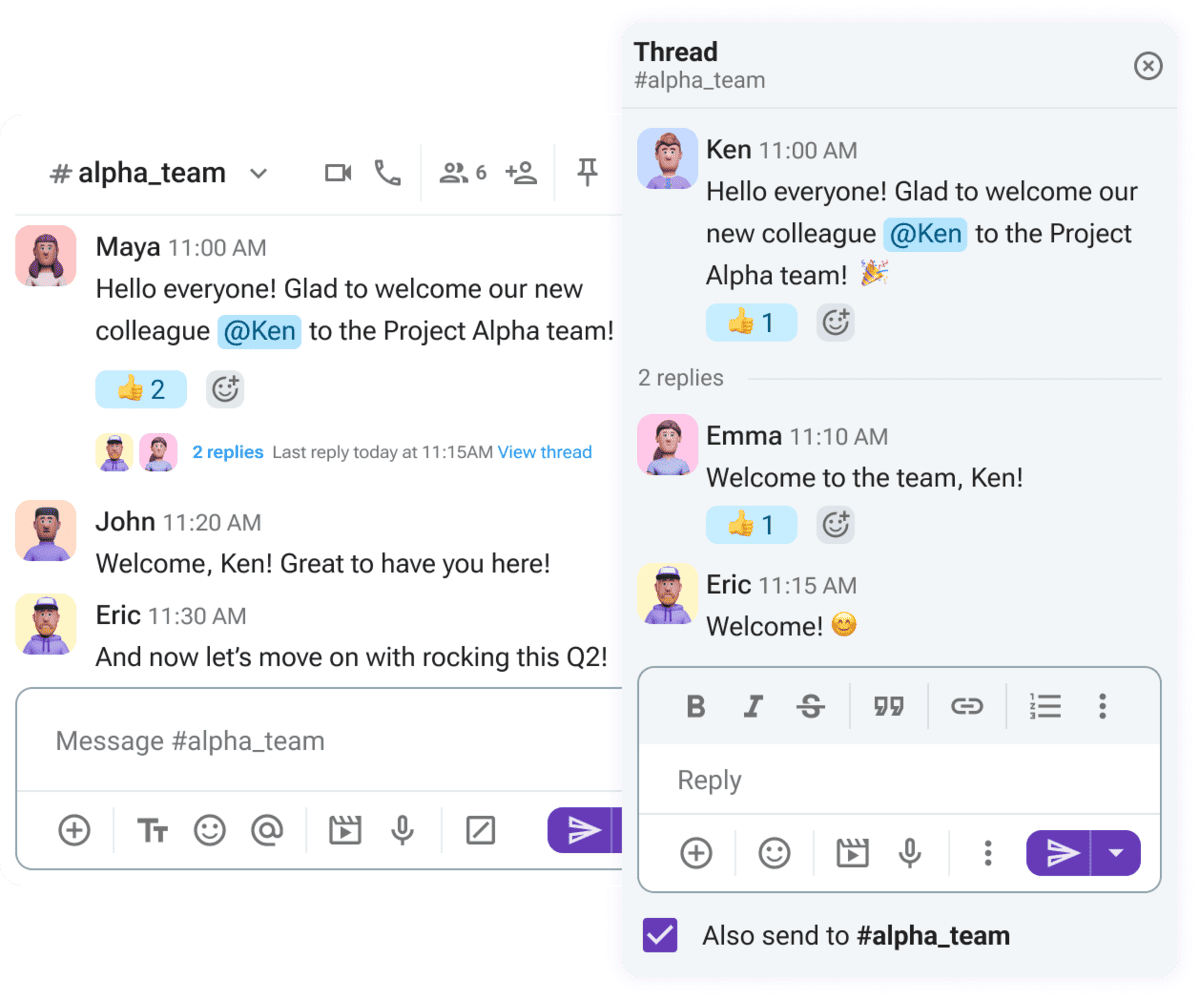
These messaging platforms aren’t new, but they have been growing in popularity over time.
💡 Pumble Pro Tip
Team communication apps can help you create a better work-life balance. To see what else you can do to establish better work boundaries, check out the following article:
Trend #4: Personalizing communication tools and channels is taking root
Employees increasingly desire a personalized digital workspace.
No matter if that is a tailored set of GIFs, specialized channels, or themes and colors that cater to our preferences, we want to leave our mark and make our workspace more personalized.
And there is nothing wrong with that.
On the contrary, it can only lead to us feeling better and more positive while working or communicating with our colleagues. For example, using customized emojis or GIFs makes communication not only easier but also more interesting.

As a result, more and more collaboration software includes various additions for customizing both our workspaces and the way we communicate.
Trend #5: Cloud-based software is becoming the norm
With remote and hybrid models firmly in place, cloud-based software has become the norm.
Cloud-based software is any system or tool that you can use and access with nothing more than an internet connection.
These are different from intranet systems that are dependent on a location.
Cloud-based tools allow teams to work and collaborate wherever they are. Most of the top communication, project management, file sharing, enterprise resource planning, SaaS CRM, and other business tools today are cloud-based.
Since remote work is here to stay, cloud-based tools will also continue to upsurge or improve with time — and, most such tools facilitate communication and collaboration.
Trend #6: Mobile-first communication is thriving
While we’re not at a point yet where all jobs can be done fully on a phone, some jobs, like survey taking, can be done via phone only.
When it comes to other jobs, the fact is that you can do more work on your phone now than you could before.
For example, you can talk to your colleagues even when you are not at your home or workplace.
To be precise, mobile-first communication allows you to:
- Track finances,
- Make notes,
- Record calls,
- Share files,
- Sign documents, and
- Do so much more.
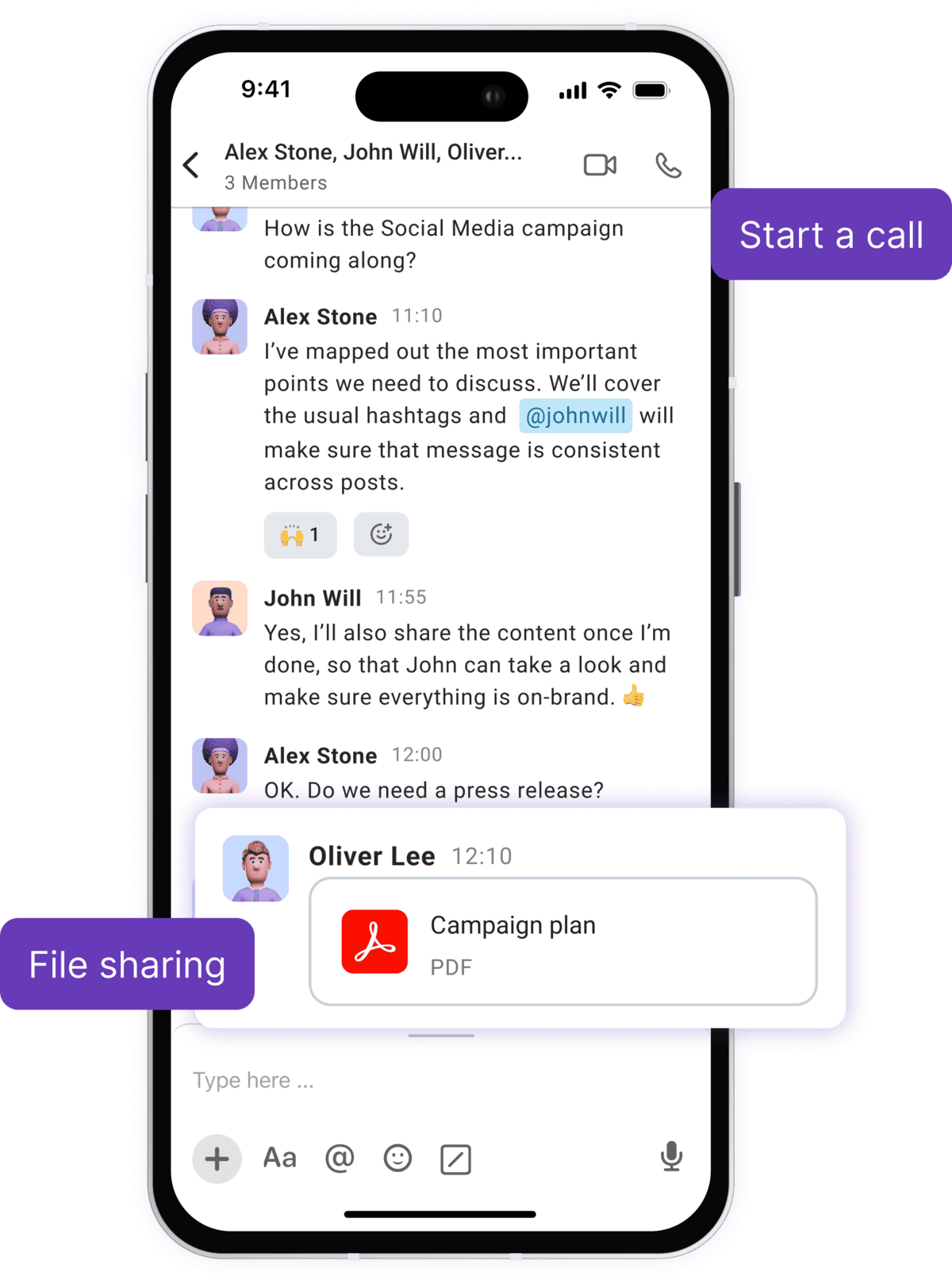
Many of the emerging trends in business communication have been moving towards a mobile-first approach.
Practically every communication tool has a mobile app or a highly-responsive website.
It’s likely we’ll see the day when every service we use for work will have a mobile app version.
Trend #7: Video is a prevalent medium in virtual communication
Video communication continues to be the most engaging and preferred internal communication method for virtual teams.
Accordingly, managers are turning to online tools to streamline operations and maintain open and constant communication without having to share the same physical space.
Furthermore, the majority of job interviews nowadays (especially in the IT industry) are being done via video calls.
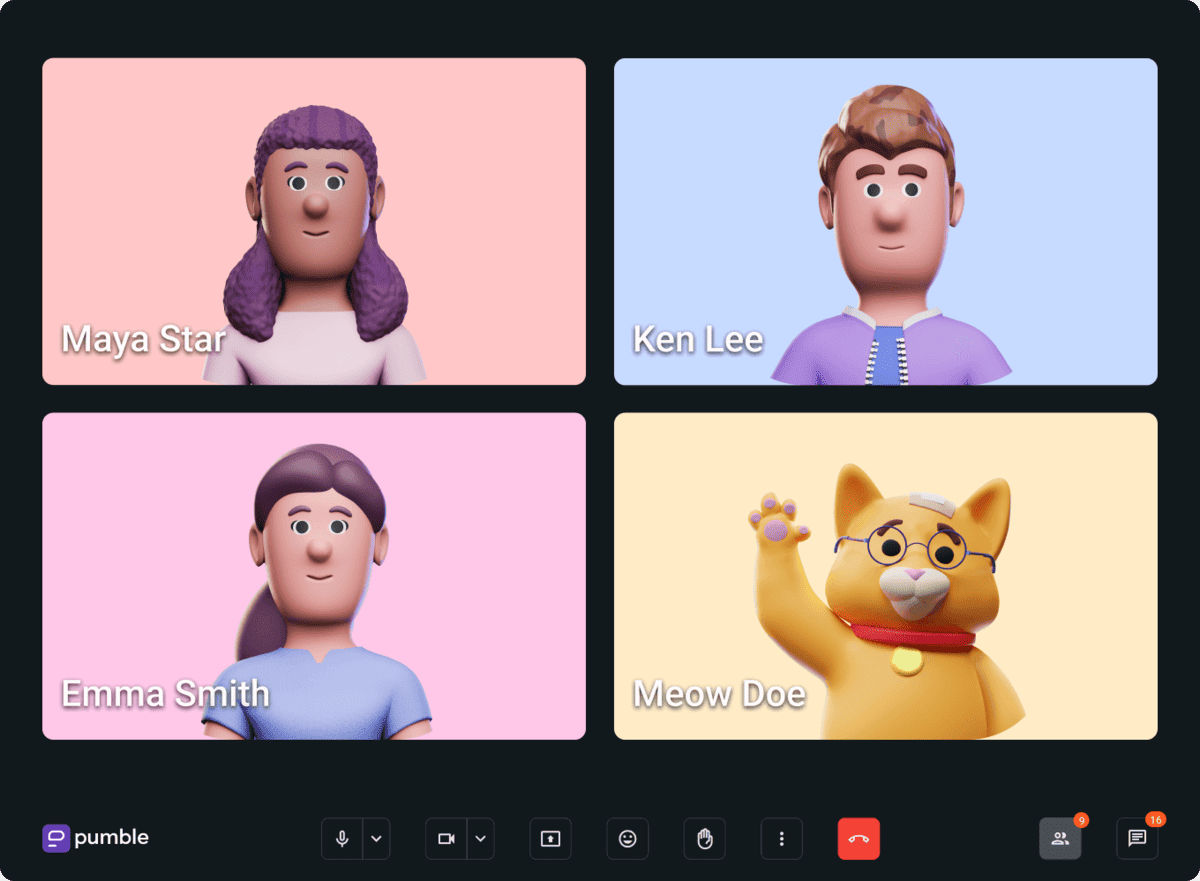
Aside from making communication more effective and engaging, video helps remote teams feel connected.
Most importantly, video chat gives us valuable nonverbal cues, helping to mitigate miscommunication and foster a sense of connection among remote colleagues.
Therefore, more and more companies prioritize video communication as a preferable internal communication medium.
💡 Pumble Pro Tip
Since the current trends in communication show us that video meetings have become extremely popular, here are some articles that can help you prepare for them:
Trend #8: Short videos are becoming more popular
Recent communication trends have shown us that short videos are sometimes the best way to communicate and teach.
They have the potential to replace traditional long onboarding sessions or company meetings, which is vital for several reasons.
First, the human attention span has decreased a lot during the last 2 decades.
Only 20 years ago, an average person could focus on one thing for about 2 and a half minutes, and nowadays, the time one can be completely concentrated on one thing is 45 seconds.
Furthermore, not many people like long corporate meetings as it’s becoming increasingly difficult to be fully attentive and maintain focus.
Finally, no matter how much you try during scheduling, there will always be people who can’t make it to the meeting for one reason or another.
To navigate all of these trends and situations, you can record a meeting (and possibly edit it to make it shorter and even more dynamic) or make a short video about the most important topics that would replace long and tedious meetings.

By doing this, you’ll be able to save time and ensure better engagement in the workplace.
Trend #9: Leaders are making the effort to beat Zoom fatigue
Even though video is currently the most engaging and powerful internal communication medium, it doesn’t mean employees are resistant to Zoom fatigue.
Not even opting for short videos or video meetings can make a massive difference, as there are some long meetings that simply can’t be avoided.
Hence, managers are finding better ways to avoid the dread associated with attending a series of online meetings.
To overcome Zoom fatigue, managers organize activities like online icebreakers and games — to get people more engaged online.
To improve meeting flow and shorten the amount of time spent on screen, they eliminate unnecessary meetings and invite only the necessary teammates to attend.
Aside from that, to avoid unnecessary video meeting overload, managers tend to share positive feedback by text message. On the other hand, they give negative feedback via video meetings to avoid miscommunication.
💡 Pumble Pro Tip
Getting employees’ attention during virtual meetings may be challenging. To find out tips on how to make virtual meetings more interactive and engaging, make sure to read our blog post:
Trend #10: Real-time feedback and a real-time communication apps go hand in hand
Real-time feedback is considered a powerful performance management strategy.
As the name suggests, real-time feedback is instant feedback that employees receive on a regular basis.
Hence, instead of waiting for annual or quarterly performance reviews, employees can get more frequent and continuous feedback to ensure they’re taking the right course of action.
Despite some beliefs that this method is not effective, studies on the influence of real-time feedback revealed the positive effects of continuous feedback on employee engagement and team performance.
Moreover, research on Gen Y and Gen Z communication styles shows that Gen Zers expect more instantaneous feedback than Gen Yers, so companies that want to attract and retain them should undoubtedly incorporate a real-time feedback system.
Furthermore, research shows that both Millennials and Centennials prefer face-to-face communication and using visuals in online communication.
Even though video calls are not exactly face-to-face, they are an adequate substitute for remote or hybrid settings.
Therefore, managers should give feedback over one-on-one video calls, and, if necessary, they can easily take advantage of screen sharing.

Thanks to instant communication software, giving and asking for frequent feedback is easier than ever before.
💡 Pumble Pro Tip
Both feedback and feedforward are considered effective people management methods. Unlike feedback, feedforward helps managers guide ongoing employees’ actions and behavior.
To learn more about how to give effective feedforward, make sure to check our blog post:
Trend #11: Enhanced focus on human-centricity and authenticity
At the core of modern business communication is a heightened focus on human-centricity and authenticity.
Businesses are prioritizing interactions that resonate deeply with their audience by blending emotional intelligence with behavioral insights, ensuring every message puts people first.
Building trust, both with customers and employees, hinges on transparency and authenticity, which means clear reporting on initiatives like sustainability and leaders who communicate genuinely.
Companies are also aware of the power of employee advocacy, and are using it to cultivate internal communities where team members can become genuine brand ambassadors by sharing their experiences.
Finally, authentic, personal storytelling, often amplified through multimedia like podcasts and video, is proving invaluable for forging deeper connections with customers.
Trend #12: Human Resources are becoming digitalized
As work shifts online, HR departments must follow emerging trends in communication.
The evolving technology in business communication makes it easier for human resource managers to get teams to collaborate online.
HR departments can now start using digital communication tools to connect staff and encourage more productivity.
These communication tools can also be used to organize virtual team-building activities or run virtual programs to boost employee morale.
While online team building used to be unthinkable, it’s now becoming a common phenomenon at work.
Trend #13: On-demand learning and virtual training are on the rise
In connection with HR training, most of the developments in learning have been towards shifting learner-to-teacher communications online.
Whether through online coaching, virtual seminars, or online interaction activities, learning is becoming digital across the board.
Now, in terms of how employees prefer to learn, there’s still a bias toward self-paced and on-demand learning.
More particularly, the statistics on eLearning revealed that 58% of employees still favor self-paced learning — and this is likely to continue in the future.
Trend #14: HR activities focus on communication training
Poor communication has been one of the biggest communication challenges since remote work started.
Due to a lack of face-to-face interaction and an inadequate way of using communication tools, employees may find it difficult to keep up with the workflow.
Hence, there’s more and more focus on HR training that helps employees acquire communication skills and learn how to deal with communication challenges.
By fostering a learning culture, employees can change their perspective and view communication difficulties as an opportunity to grow personally and professionally.
Therefore, to empower employees with communication skills, HR specialists create training programs for:
- Conflict resolution,
- Giving feedback,
- Active listening, and
- Dealing with miscommunication.
Trend #15: User experience is becoming a priority when choosing communication tools
As remote work and communication grow, user experience and design in these business communication apps are key for effective and efficient communication.
For example, project management apps are among those tools that companies seem to be using more.
And, if these apps have a steep learning curve, project team members will choose not to use them — so, picking the right apps is key.
The goal of user experience is simplicity.
And, simplicity in communication is key to the effectiveness of the “new normal” of work — i.e. the workflows of remote, hybrid, and distributed teams.
For example, since some apps now let us communicate our availability status with an emoji, many users have stopped using apps where they have to waste time typing what they are doing in detail.
Hence, managers will continue to be on the lookout for communication tools that are simple and easy to use.
Trend #16: Automation is gaining popularity
The recent trends in business communication point toward automation.
The automation in communication can include options like:
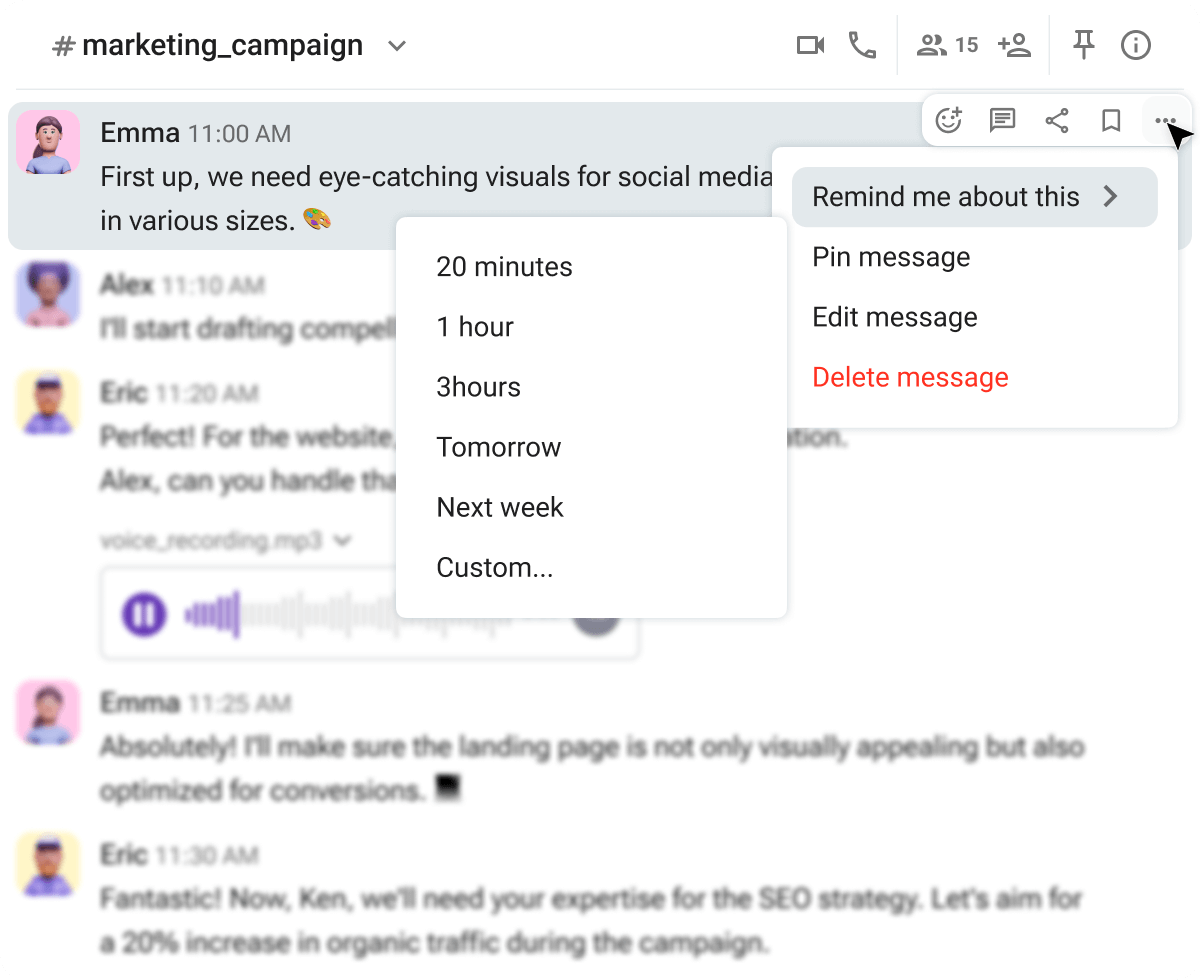
More advanced communication tools now even have app integrations that allow these work apps to communicate with other software — to save time, energy, and resources.
All of this is improving teamwork — and, consequently, helping streamline business processes.
For example, automated reminders make it less likely for teams to miss scheduled video calls — so, it gets easier to have more video calls because it’s easy to keep track of who you should hop on a call with, and when.
Trend #17: C-level executives are more involved in internal communication
In well-connected organizations, C-level executives are an active part of internal communication.
Whether they reach out via Pumble messages or organize video calls, it’s important that all employees can hear directly from their C-level executives.
This way, CEOs engage with their employees, which improves group cohesion and helps them to make sure that everyone is on the same page.
💡 Pumble Pro Tip
Downward communication, also known as top-down communication, occurs when leaders or managers share information with lower-level employees. To learn more about how to make downward communication successful, make sure to check out our blog post:
Trend #18: Employee mental health is more important than ever
As awareness of the importance of mental health has increased over the last few years, supporting employees’ mental, physical, and emotional health is becoming the norm.
In remote and hybrid work settings, the ideal way to support employees is to share valuable employee wellness resources and offer support in internal communication channels.
Also, organizations and companies should spread the word about healthy work-life balance and burnout prevention.
Most importantly, companies should listen to employees’ voices and understand what type of support they need.
To do so, companies can use various techniques such as employee wellness surveys or feedback surveys on their mental health.
Trend #19: AI is becoming more and more used
AI has taken the world by storm.
It was inevitable that it would become a part of daily work routines, sooner or later.
Its job is and will be to save precious time, go through databases, and provide us with the information we need.
When it comes to messaging, AI has brought some serious changes.
If we want, we can ask it to change our voice and style and make us sound more professional or more relaxed, depending on our mood and the purpose of our writing.
In 2025, AI’s role has expanded beyond basic functions and has more advanced features for:
- Hyper-personalization: AI analyzing communication patterns to suggest optimal tones and phrasing, or even drafting initial responses tailored to specific recipients.
- Content generation: AI-powered tools assisting with the creation of meeting summaries, internal announcements, or even short video scripts.
- Predictive analytics: AI identifying potential communication bottlenecks or areas where information flow could be improved before issues arise.
- Enhanced accessibility: AI providing real-time translation and transcription, making communication more inclusive for diverse teams.
In the future, we can expect an even larger number of AI features that will contribute to better productivity and creativity.
Pumble enables easier adaptation to the recent trends in communication
Both now and in the near future, teams will aim to streamline their business communication — mostly through the use of the right communication tools.
When a team communication app has an adequate infrastructure, it is easier to include additions that enable smoother and more centralized communication.
Pumble has always adapted to the latest trends in communication and enabled its users to have every feature they need for an affordable price.
Even when some of its competitors are deleting some much-needed features, such as unlimited message history, Pumble stays loyal to its main idea — providing value and quality.
And it will continue to do so in the future.
Pumble by CAKE.com is devoted to helping teams exchange ideas, information, and input — even if they don’t have physical offices.
Conquer the latest communication trends and ensure maximum productivity in your team — sign up for Pumble today!
And, if you would like to try our other apps and see why they are packed with value, try the CAKE.com Productivity Bundle today!

